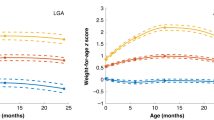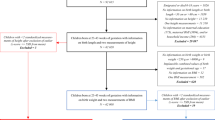Abstract
Background:
Low-birth weight has been proposed to programme central adiposity in childhood. However, there is little information on associations between fetal weight gain and fat distribution within obese individuals.
Objectives:
To investigate associations between birth weight and postnatal weight gain with body composition in a sample of obese children and adolescents.
Subjects and methods:
Body composition was measured using anthropometry, dual-emission X-ray absorptiometry and the 4-component model in 45 male and 76 female obese individuals aged 5–22 years. General linear models were used to investigate associations between birth weight standard deviation score (SDS), or change in weight SDS between birth and follow-up, and body composition, adjusting for age, pubertal status, height and gender.
Results:
Birth weight SDS ranged from −1.86 to 3.46, and was inversely associated with current weight SDS after adjustment for height SDS. Birth weight SDS was weakly associated with waist and hip girths, but not waist–hip ratio or trunk fat, after adjusting for age, height, pubertal status and gender. Change in weight SDS was strongly associated with total and central adiposity.
Conclusions:
Despite incorporating substantial variability, birth weight SDS was only a weak predictor of tissue masses and their distribution in obese children. Variability in central adiposity was more strongly associated with the magnitude of postnatal growth, which in turn was weakly inversely associated with birth weight SDS. In a population uniformly characterised by excess body weight, postnatal weight gain exerted the dominant impact on adiposity and fat distribution.
This is a preview of subscription content, access via your institution
Access options
Subscribe to this journal
Receive 12 print issues and online access
$259.00 per year
only $21.58 per issue
Buy this article
- Purchase on Springer Link
- Instant access to full article PDF
Prices may be subject to local taxes which are calculated during checkout





Similar content being viewed by others
References
Ludwig DS, Peterson KE, Gortmaker SL . Relation between consumption of sugar-sweetened drinks and childhood obesity: a prospective, observational analysis. Lancet 2001; 357: 505–508.
Ludwig DS . Childhood obesity—the shape of things to come. N Engl J Med 2007; 357: 2325–2327.
Ekelund U, Aman J, Yngve A, Renman C, Westerterp K, Sjostrom M . Physical activity but not energy expenditure is reduced in obese adolescents: a case-control study. Am J Clin Nutr 2002; 76: 935–941.
Ong KK, Ahmed ML, Emmett PM, Preece MA, Dunger DB . Association between postnatal catch-up growth and obesity in childhood: prospective cohort study. BMJ 2000; 320: 967–971.
Stettler N, Kumanyika SK, Katz SH, Zemel BS, Stallings VA . Rapid weight gain during infancy and obesity in young adulthood in a cohort of African Americans. Am J Clin Nutr 2003; 77: 1374–1378.
Stettler N, Tershakovec AM, Zemel BS, Leonard MB, Boston RC, Katz SH et al. Early risk factors for increased adiposity: a cohort study of African American subjects followed from birth to young adulthood. Am J Clin Nutr 2000; 72: 378–383.
Ong KK, Northstone K, Wells JC, Rubin C, Ness AR, Golding J et al. Earlier mother's age at menarche predicts rapid infancy growth and childhood obesity. PLoS Med 2007; 4: e132.
Ong KK, Preece MA, Emmett PM, Ahmed ML, Dunger DB . Size at birth and early childhood growth in relation to maternal smoking, parity and infant breast-feeding: longitudinal birth cohort study and analysis. Pediatr Res 2002; 52: 863–867.
Wells JC, Chomtho S, Fewtrell MS . Programming of body composition by early growth and nutrition. Proc Nutr Soc 2007; 66: 423–434.
Kahn HS, Narayan KM, Williamson DF, Valdez R . Relation of birth weight to lean and fat thigh tissue in young men. Int J Obes Relat Metab Disord 2000; 24: 667–672.
Okosun IS, Liao Y, Rotimi CN, Dever GE, Cooper RS . Impact of birth weight on ethnic variations in subcutaneous and central adiposity in American children aged 5–11 years. A study from the Third National Health and Nutrition Examination Survey. Int J Obes Relat Metab Disord 2000; 24: 479–484.
Garnett SP, Cowell CT, Baur LA, Fay RA, Lee J, Coakley J et al. Abdominal fat and birth size in healthy prepubertal children. Int J Obes Relat Metab Disord 2001; 25: 1667–1673.
Malina RM, Katzmarzyk PT, Beunen G . Birth weight and its relationship to size attained and relative fat distribution at 7–12 years of age. Obes Res 1996/7; 4: 385–390.
Rogers IS, Ness AR, Steer CD, Wells JC, Emmett PM, Reilly JR et al. Associations of size at birth and dual-energy X-ray absorptiometry measures of lean and fat mass at 9–10 y of age. Am J Clin Nutr 2006/10; 84: 739–747.
Chomtho S, Wells JC, Williams JE, Lucas A, Fewtrell MS . Associations between birth weight and later body composition: evidence from the 4-component model. Am J Clin Nutr 2008; 88: 1040–1048.
Euser AM, Finken MJ, Keijzer-Veen MG, Hille ET, Wit JM, Dekker FW . Associations between prenatal and infancy weight gain and BMI, fat mass, and fat distribution in young adulthood: a prospective cohort study in males and females born very preterm. Am J Clin Nutr 2005; 81: 480–487.
Lucas A, Fewtrell MS, Cole TJ . Fetal origins of adult disease-the hypothesis revisited. BMJ 1999; 319: 245–249.
Wells JC, Cole TJ, Bruner D, Treleaven P . Body shape in American and British adults: between-country and inter-ethnic comparisons. Int J Obes (Lond) 2008; 32: 152–159.
Park YW, Allison DB, Heymsfield SB, Gallagher D . Larger amounts of visceral adipose tissue in Asian Americans. Obes Res 2001; 9: 381–387.
Yajnik CS, Yudkin JS . The Y-Y paradox. Lancet 2004; 363: 163.
Harding S, Rosato MG, Cruickshank JK . Lack of change in birthweights of infants by generational status among Indian, Pakistani, Bangladeshi, Black Caribbean, and Black African mothers in a British cohort study. Int J Epidemiol 2004; 33: 1279–1285.
Shiono PH, Klebanoff MA, Graubard BI, Berendes HW, Rhoads GG . Birth weight among women of different ethnic groups. JAMA 1986; 255: 48–52.
Wells JC, Williams JE, Chomtho S, Darch T, Grijalva-Eternod C, Kennedy K et al. Pediatric reference data for lean tissue properties: density and hydration from age 5–20 y. Am J Clin Nutr 2010; 91: 610–618.
Haroun D, Croker H, Viner RM, Williams JE, Darch TS, Fewtrell MS et al. Validation of BIA in obese children and adolescents and re-evaluation in a longitudinal study. Obesity (Silver Spring) 2009; 17: 2245–2250.
Cole TJ, Freeman JV, Preece MA . Body mass index reference curves for the UK, 1990. Arch Dis Child 1995; 73: 25–29.
Freeman JV, Cole TJ, Chinn S, Jones PR, White EM, Preece MA . Cross sectional stature and weight reference curves for the UK, 1990. Arch Dis Child 1995; 73: 17–24.
McCarthy HD, Jarrett KV, Crawley HF . The development of waist circumference percentiles in British children aged 5.0–16.9 y. Eur J Clin Nutr 2001; 55: 902–907.
Wells JC, Fuller NJ, Dewit O, Fewtrell MS, Elia M, Cole TJ . Four-component model of body composition in children: density and hydration of fat-free mass and comparison with simpler models. Am J Clin Nutr 1999; 69: 904–912.
Wells JC, Fuller NJ . Precision of measurement and body size in whole-body air-displacement plethysmography. Int J Obes Relat Metab Disord 2001; 25: 1161–1167.
Chomtho S, Fewtrell MS, Jaffe A, Williams JE, Wells JC . Evaluation of arm anthropometry for assessing pediatric body composition: evidence from healthy and sick children. Pediatr Res 2006; 59: 860–865.
Fuller NJ, Jebb SA, Laskey MA, Coward WA, Elia M . Four-component model for the assessment of body composition in humans: comparison with alternative methods, and evaluation of the density and hydration of fat-free mass. Clin Sci (Lond) 1992; 82: 687–693.
Stettler N, Zemel BS, Kumanyika S, Stallings VA . Infant weight gain and childhood overweight status in a multicenter, cohort study. Pediatrics 2002; 109: 194–199.
Ibanez L, Ong K, Dunger DB, de ZF . Early development of adiposity and insulin resistance after catch-up weight gain in small-for-gestational-age children. J Clin Endocrinol Metab 2006; 91: 2153–2158.
Wells JC, Fewtrell MS, Williams JE, Haroun D, Lawson MS, Cole TJ . Body composition in normal weight, overweight and obese children: matched case–control analyses of total and regional tissue masses, and body composition trends in relation to relative weight. Int J Obes (Lond) 2006; 30: 1506–1513.
Ezzahir N, Alberti C, Deghmoun S, Zaccaria I, Czernichow P, Levy-Marchal C et al. Time course of catch-up in adiposity influences adult anthropometry in individuals who were born small for gestational age. Pediatr Res 2005; 58: 243–247.
Wong WW, Hergenroeder AC, Stuff JE, Butte NF, Smith EO, Ellis KJ . Evaluating body fat in girls and female adolescents: advantages and disadvantages of dual-energy X-ray absorptiometry. Am J Clin Nutr 2002; 76: 384–389.
Williams JE, Wells JC, Wilson CM, Haroun D, Lucas A, Fewtrell MS . Evaluation of Lunar Prodigy dual-energy X-ray absorptiometry for assessing body composition in healthy persons and patients by comparison with the criterion 4-component model. Am J Clin Nutr 2006; 83: 1047–1054.
Acknowledgements
We gratefully acknowledge funding from the Child Growth Foundation for Dalia Haroun. The study was designed by JCKW. Data were collected by DH, DL and JEW under the supervision of JCKW and MSF. Isotope analyses were conducted by TD. Statistical analyses were conducted by JCKW and DL. JCKW wrote the first draft of the manuscript. All authors contributed to subsequent revisions.
Author information
Authors and Affiliations
Corresponding author
Ethics declarations
Competing interests
The authors declare no conflict of interest.
Rights and permissions
About this article
Cite this article
Wells, J., Haroun, D., Levene, D. et al. Prenatal and postnatal programming of body composition in obese children and adolescents: evidence from anthropometry, DXA and the 4-component model. Int J Obes 35, 534–540 (2011). https://doi.org/10.1038/ijo.2011.7
Received:
Revised:
Accepted:
Published:
Issue Date:
DOI: https://doi.org/10.1038/ijo.2011.7
Keywords
This article is cited by
-
Effects of an antenatal dietary intervention in overweight and obese women on 6 month infant outcomes: follow-up from the LIMIT randomised trial
International Journal of Obesity (2018)
-
The effects of dietary and lifestyle interventions among pregnant women who are overweight or obese on longer-term maternal and early childhood outcomes: protocol for an individual participant data (IPD) meta-analysis
Systematic Reviews (2017)
-
Metformin and dietary advice to improve insulin sensitivity and promote gestational restriction of weight among pregnant women who are overweight or obese: the GRoW Randomised Trial
BMC Pregnancy and Childbirth (2016)
-
Infant weight growth velocity patterns and general and abdominal adiposity in school-age children. The Generation R Study
European Journal of Clinical Nutrition (2016)
-
The effects of antenatal dietary and lifestyle advice for women who are overweight or obese on neonatal health outcomes: the LIMIT randomised trial
BMC Medicine (2014)



